The Ionospheric Plasma Perturbations before a Sequence of Strong Earthquakes in Southeast Asia and Northern Oceania in 2018
Abstract
:1. Introduction
2. Data and Methods
2.1. Seismic Data
2.2. CSES-01 Satellite Data
2.3. Geomagnetic and Solar Conditions Data
2.4. Method
3. Results
3.1. Single-Orbit Analysis
3.2. Multi-Orbit Analysis
4. Discussion
4.1. Spatial Distributions of EQ Precursor
4.2. Mechanism of the Seismo-Ionospheric Coupling
4.3. Difference with Magnetic Storm Anomaly
5. Conclusions
- (1)
- The No+, Ne, Te, and Vz values show significant synchronous disturbances at the same position near the epicenters from 1 to 15 days before the series of strong EQs occurred in southeast Asia and northern Oceania within 50 days. Regarding time and space characteristics, these plasma perturbations are possibly explained as seismo-ionospheric precursors.
- (2)
- The No+ and Vz seemed like promising parameters for analyzing ionospheric disturbances excited by strong seismic activity. Local ionospheric perturbations caused by strong EQs are often accompanied by a change in Vz, which is not easily influenced by the geomagnetic storm. Meanwhile, the variation of No+ could reflect the combined effects induced by strong EQ and intense geomagnetic storms on the ionospheric plasma environment.
- (3)
- Based on the long-term data analysis results of CSES-01, the absolute value differences of plasma in different locations are large. It may be more effective to extract precursory seismic anomalies by long-term monitoring of the critical areas and checking the relative abnormal changes of the revisiting orbits.
Author Contributions
Funding
Data Availability Statement
Acknowledgments
Conflicts of Interest
References
- Pulinets, S.A.; Boyarchuk, K.A.; Hegai, V.V.; Kim, V.P.; Lomonosov, A.M. Quasielectrostatic model of atmosphere-thermosphere-ionosphere coupling. Adv. Space Res. 2000, 26, 1209–1218. [Google Scholar] [CrossRef]
- Yokoyama, T.; Su, S.Y.; Fukao, S. Plasma blobs and irregularities concurrently observed by ROCSAT-1 and Equatorial At-mosphere Radar. J. Geophys. Res. Space Phys. 2007, 112, 515–526. [Google Scholar] [CrossRef]
- Liu, J.Y.; Chen, C.H.; Lin, C.H.; Tsai, H.F.; Kamogawa, M. Ionospheric disturbances triggered by the 11 March 2011 M9.0 Tohoku earthquake. J. Geophys. Res. Space Phys. 2011, 116, A06319. [Google Scholar] [CrossRef]
- Pulinets, S.; Ouzounov, D. Lithosphere–Atmosphere–Ionosphere Coupling (LAIC) model—An unified concept for earthquake precursors validation. J. Asian Earth Sci. 2011, 41, 371–382. [Google Scholar] [CrossRef]
- Macmillan, S.; Olsen, N. Observatory data and the Swarm mission. Earth Planets Space 2013, 65, 1355–1362. [Google Scholar] [CrossRef]
- Maruyama, T.; Shinagawa, H. Infrasonic sounds excited by seismic waves of the 2011 Tohoku-oki earthquake as visualized in ionograms. J. Geophys. Res. Space Phys. 2014, 119, 4094–4108. [Google Scholar] [CrossRef]
- Parrot, M.; Benoist, D.; Berthelier, J.; Błęcki, J.J.; Chapuis, Y.; Colin, F.; Elie, F.; Fergeau, P.; Lagoutte, D.; Lefeuvre, F.; et al. The magnetic field experiment IMSC and its data processing onboard DEMETER: Scientific objectives, description and first results. Plan. Space Sci. 2006, 54, 441–455. [Google Scholar] [CrossRef]
- Cussac, T.; Clair, M.A.; Ultré-Guerard, P.; Buisson, F.; Rey, N. The DEMETER microsatellite and ground segment. Plan. Space Sci. 2006, 54, 413–427. [Google Scholar] [CrossRef]
- Berthelier, J.; Godefroy, M.; Leblanc, F.; Seran, E.; Peschard, D.; Gilbert, P.; Artru, J. IAP, the thermal plasma analyzer on DEMETER. Plan. Space Sci. 2006, 54, 487–501. [Google Scholar] [CrossRef]
- De Santis, A.; Marchetti, D.; Pavón-Carrasco, F.J.; Cianchini, G.; Perrone, L.; Abbattista, C.; Alfonsi, L.; Amoruso, L.; Campuzano, S.A.; Carbone, M.; et al. Precursory worldwide signatures of earthquake occurrences on Swarm satellite data. Sci. Rep. 2019, 9, 20287. [Google Scholar] [CrossRef]
- Liu, J.Y.; Chen, Y.I.; Pulinets, S.A.; Tsai, Y.B.; Chuo, Y.J. Seismo-ionospheric signatures prior to M ≥ 6.0 Taiwan earthquakes. Geophys. Res. Lett. 2000, 27, 3113–3116. [Google Scholar] [CrossRef]
- Ouyang, X.; Zhang, X.; Shen, X.; Huang, J.; Liu, J.; Zeren, Z.; Zhao, S. Disturbance of O+ Density Before Major Earthquake Detected by DEMETER Satellite. Chin. J. Space Sci. 2011, 31, 607–617. [Google Scholar] [CrossRef]
- Piersanti, M.; Materassi, M.; Battiston, R.; Carbone, V.; Cicone, A.; D’angelo, G.; Diego, P.; Ubertini, P. Magnetospheric–Ionospheric–Lithospheric Coupling Model. 1: Observations during the 5 August 2018 Bayan Earthquake. Remote Sens. 2020, 12, 3299. [Google Scholar] [CrossRef]
- Liu, D.; Zeren, Z.; Shen, X.; Zhao, S.; Yan, R.; Wang, X.; Liu, C.; Guan, Y.; Zhu, X.; Miao, Y.; et al. Typical ionospheric disturbances revealed by the plasma analyzer package onboard the China Seismo-Electromagnetic Satellite. Adv. Space Res. 2021, 68, 3796–3805. [Google Scholar] [CrossRef]
- Li, M.; Shen, X.; Parrot, M.; Zhang, X.; Zhang, Y.; Yu, C.; Yan, R.; Liu, D.; Lu, H.; Guo, F.; et al. Primary Joint Statistical Seismic Influence on Ionospheric Parameters Recorded by the CSES and DEMETER Satellites. J. Geophys. Res. Space Phys. 2020, 125, e2020JA028116. [Google Scholar] [CrossRef]
- Li, Z.; Yang, B.; Huang, J.; Yin, H.; Yang, X.; Liu, H.; Zhang, F.; Lu, H. Analysis of pre-earthquake space electric field disturbance observed by CSES. Atmosphere 2022, 13, 934. [Google Scholar] [CrossRef]
- Song, R.; Hattori, K.; Zhang, X.; Sanaka, S. Seismic-ionospheric effects prior to four earthquakes in Indonesia detected by the China seismo-electromagnetic satellite. J. Atmos. Terr. Phys. 2020, 205, 105291. [Google Scholar] [CrossRef]
- Zeren, Z.; Yan, R.; Lin, J.; Wang, Q.; Yang, Y.; Lv, F.; Huang, J.; Cui, J.; Liu, Q.; Zhao, S.; et al. The Possible Seismo-Ionospheric Perturbations Recorded by the China-Seismo-Electromagnetic Satellite. Remote Sens. 2022, 14, 905. [Google Scholar] [CrossRef]
- Liu, J.; Qiao, X.; Zhang, X.; Wang, Z.; Zhou, C.; Zhang, Y. Using a Spatial Analysis Method to Study the Seismo-Ionospheric Disturbances of Electron Density Observed by China Seismo-Electromagnetic Satellite. Front. Earth Sci. 2022, 10, 811658. [Google Scholar] [CrossRef]
- Oyama, K.-I.; Devi, M.; Ryu, K.; Chen, C.H.; Liu, J.Y.; Liu, H.; Bankov, L.; Kodama, T. Modifications of the ionosphere prior to large earthquakes: Report from the Ionosphere Precursor Study Group. Geosci. Lett. 2016, 3, 6. [Google Scholar] [CrossRef]
- Yang, Y.; Zhima, Z.; Shen, X.; Chu, W.; Huang, J.; Wang, Q.; Yan, R.; Xu, S.; Lu, H.; Liu, D. The First Intense Geomagnetic Storm Event Recorded by the China Seismo-Electromagnetic Satellite. Space Weather. 2020, 18, e2019SW002243. [Google Scholar] [CrossRef]
- Marchitelli, V.; Harabaglia, P.; Troise, C.; De Natale, G. On the correlation between solar activity and large earthquakes worldwide. Sci. Rep. 2020, 10, 11495. [Google Scholar] [CrossRef] [PubMed]
- Dobrovolsky, I.P.; Zubkov, S.I.; Miachkin, V.I. Estimation of the size of earthquake preparation zones. Pure Appl. Geophys. 1979, 117, 1025–1044. [Google Scholar] [CrossRef]
- Huang, J.; Lei, J.; Li, S.; Zeren, Z.; Li, C.; Zhu, X.; Yu, W. The Electric Field Detector (EFD) onboard the ZH-1 satellite and first observational results. Earth Planet. Phys. 2018, 2, 469–478. [Google Scholar] [CrossRef]
- Zhang, Y.; Wang, T.; Chen, W.; Zhu, K.; Marchetti, D.; Cheng, Y.; Fan, M.; Wang, S.; Wen, J.; Zhang, D.; et al. Are There One or More Geophysical Coupling Mechanisms before Earthquakes? The Case Study of Lushan (China) 2013. Remote Sens. 2023, 15, 1521. [Google Scholar] [CrossRef]
- Takeuchi, A.; Lau, B.; Freund, F. Current and surface potential induced by stress-activated positive holes in igneous rocks. Phys. Chem. Earth 2006, 31, 240–247. [Google Scholar] [CrossRef]
- Kuo, C.L.; Huba, J.D.; Joyce, G.; Lee, L.C. Ionosphere plasma bubbles and density variations induced by pre-earthquake rock currents and associated surface charges. J. Geophys. Res. Space Phys. 2011, 116, A10317. [Google Scholar] [CrossRef]
- Liu, J.; Wan, W. Spatial-temporal distribution of the ionospheric perturbations prior to MS ≥ 6.0 earthquakes in China main land. Chin. J. Geophys. 2014, 57, 2181–2189. [Google Scholar] [CrossRef]
- Bell, T.; Graf, K.; Inan, U.; Piddyachiy, D.; Parrot, M. DEMETER observations of ionospheric heating by powerful VLF transmitters. Geophys. Res. Lett. 2011, 38, L11103. [Google Scholar] [CrossRef]
- Tao, D.; Liu, W.; Ma, Y. Plasma perturbations in the coexisting environment of VLF transmitter emission, lightning strokes and seismic activity. Sci. China Technol. Sci. 2018, 61, 678–686. [Google Scholar] [CrossRef]
- Appleton, E.V. Two Anomalies in the Ionosphere. Nature 1946, 157, 691. [Google Scholar] [CrossRef]
- Whalen, J.A. Mapping a bubble at dip equator and anomaly with oblique ionospheric soundings of range spread F. J. Geophys. Res. 1996, 101, 5185–5193. [Google Scholar] [CrossRef]
- Hanson, W.B.; Moffett, R.J. Ionization transport effects in the equatorial F region. J. Geophys. Res. 1966, 71, 5559–5572. [Google Scholar] [CrossRef]
- Abdu, M.A. Major phenomena of the equatorial ionosphere-thermosphere system under disturbed conditions. J. Atmos. Terres. Phys. 1997, 59, 1505–1519. [Google Scholar] [CrossRef]
- Wu, L.; Qi, Y.; Mao, W.; Lu, J.; Ding, Y.; Peng, B.; Xie, B. Scrutinizing and rooting the multiple anomalies of Nepal earthquake sequence in 2015 with the deviation–time–space criterion and homologous lithosphere–coversphere–atmosphere–ionosphere coupling physics. Nat. Hazards Earth Syst Sci. 2023, 23, 231–249. [Google Scholar] [CrossRef]
- Guo, Y.; Zhang, X.; Liu, J.; Yang, M.; Yang, X.; Du, X.; Lü, J.; Xiao, J. Seismo-Ionospheric Effects Prior to Two Earthquakes in Taiwan Detected by the China Seismo-Electromagnetic Satellite. Atmosphere 2022, 13, 1523. [Google Scholar] [CrossRef]
- Akhoondzadeh, M.; Parrot, M.; Saradjian, M.R. Electron and ion density variations before strong earthquakes (M > 6.0) using DEMETER and GPS data. Nat. Hazards Earth Syst. Sci. 2010, 10, 7–18. [Google Scholar] [CrossRef]
- Freund, F.T.; Kulahci, I.G.; Cyr, G.; Ling, J.; Winnick, M.; Tregloan-Reed, J.; Freund, M.M. Air ionization at rock surfaces and pre-earthquake signals. J. Atmos. Solar-Terr. Phys. 2009, 71, 1824–1834. [Google Scholar] [CrossRef]
- Freund, F.T. Earthquake forewarning—A multidisciplinary challenge from the ground up to space. Acta Geophys. 2013, 61, 775–807. [Google Scholar] [CrossRef]
- Freund, F.T.; Daneshvar, M.M.; Ebrahimi, M. Atmospheric Storm Anomalies Prior to Major Earthquakes in the Japan Region. Sustainability 2022, 14, 10241. [Google Scholar] [CrossRef]
- Kuo, C.L.; Lee, L.C.; Huba, J.D. An improved coupling model for the lithosphere-atmosphere-ionosphere system. J. Geophys. Res. Space Phys. 2014, 119, 3189–3205. [Google Scholar] [CrossRef]
- Ruzhin, Y.Y.; Sorokin, V.M.; Yashchenko, A.K. Physical mechanism of ionospheric total electron content perturbations over a seismoactive region. Geomagn. Aeron. 2014, 54, 337–346. [Google Scholar] [CrossRef]
- Wait, J.R. Mode conversion and refraction effects in the Earth-ionosphere waveguide for VLF radio waves. J. Geophys. Res. Atmos. 1968, 73, 3537–3548. [Google Scholar] [CrossRef]
- Zhao, S.; Liao, L.; Zhang, X. Trans-ionospheric VLF wave power absorption of terrestrial VLF signal. Chin. J. Geophys. 2017, 60, 3004–3014. [Google Scholar] [CrossRef]
- Fu, S.; Pu, Z.; Zong, Q.; Xiao, C.; Xie, L.; Wilken, B. Ion composition variations in the ring current during intense magnetic storms and their relationship with evolution of storms. Chin. J. Geophys. 2001, 44, 1–11. [Google Scholar] [CrossRef]
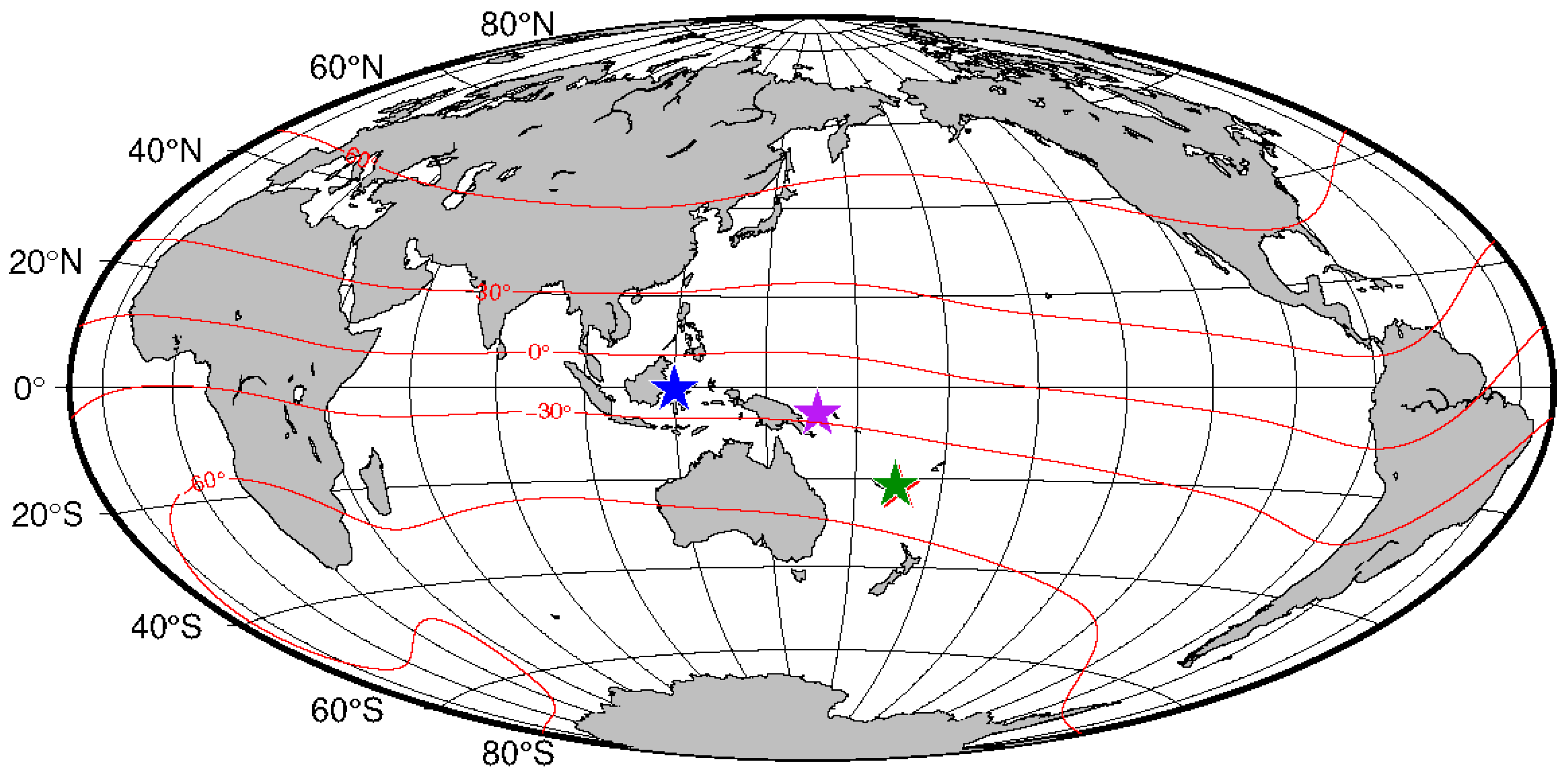


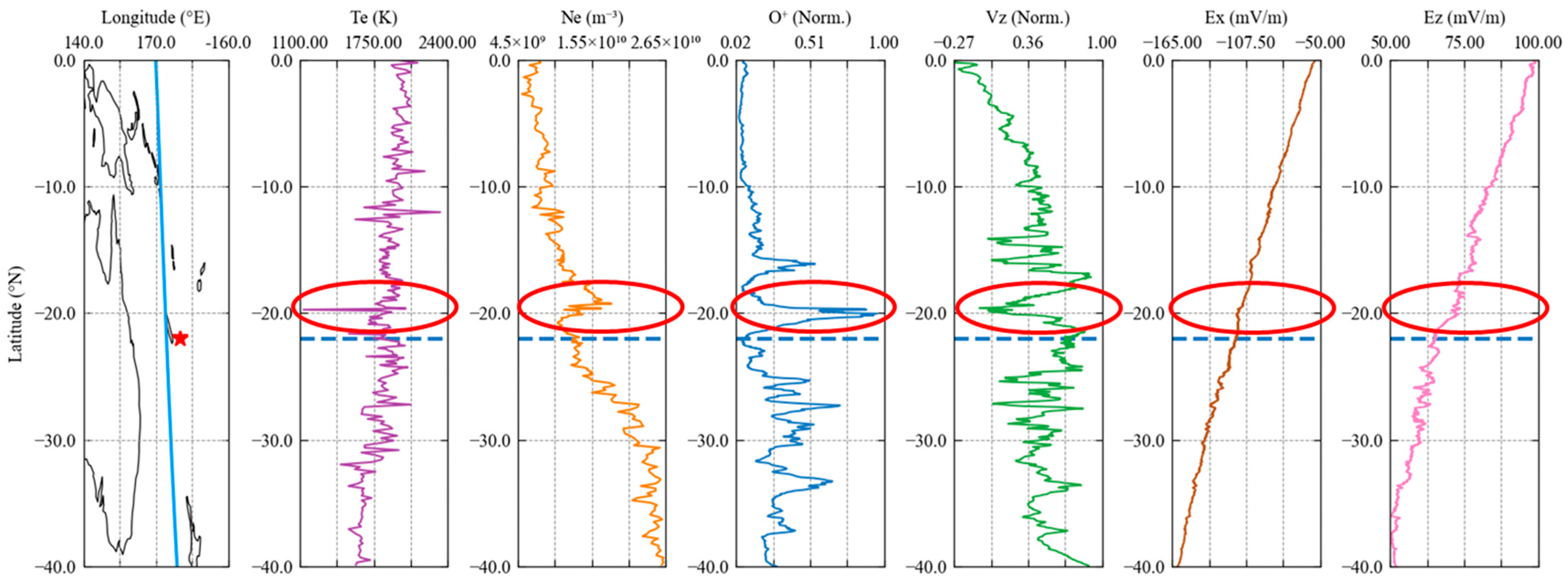
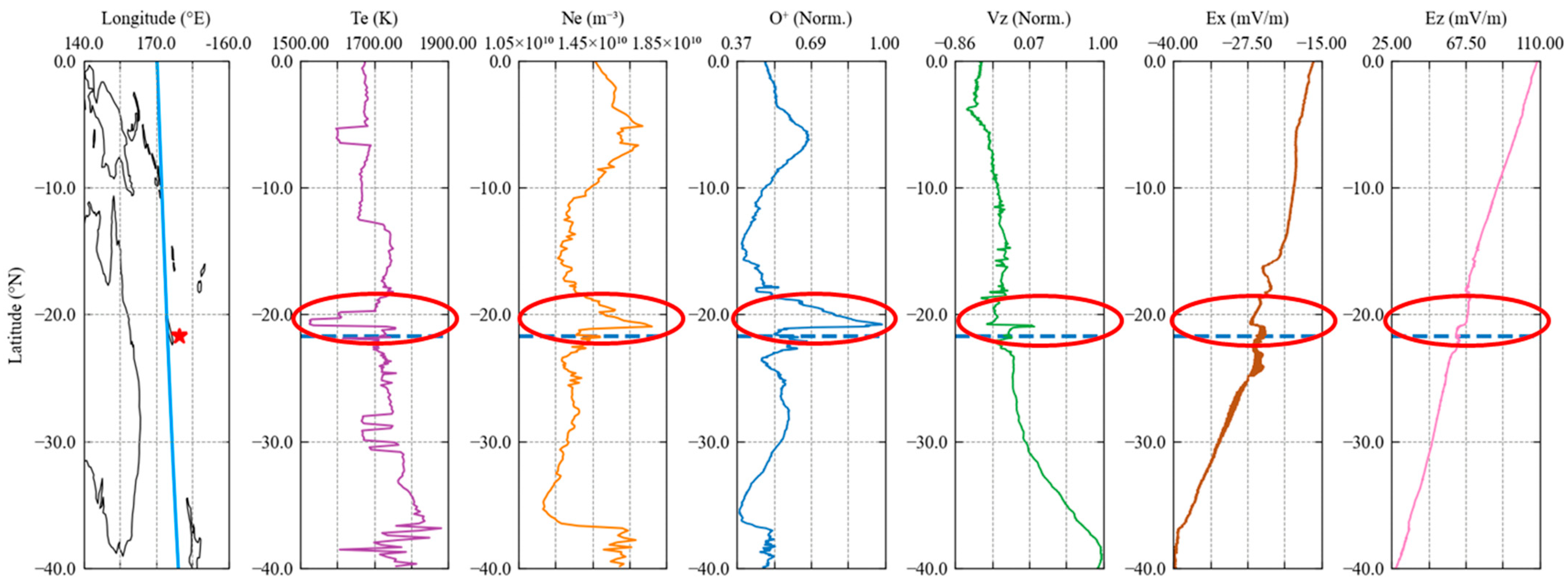
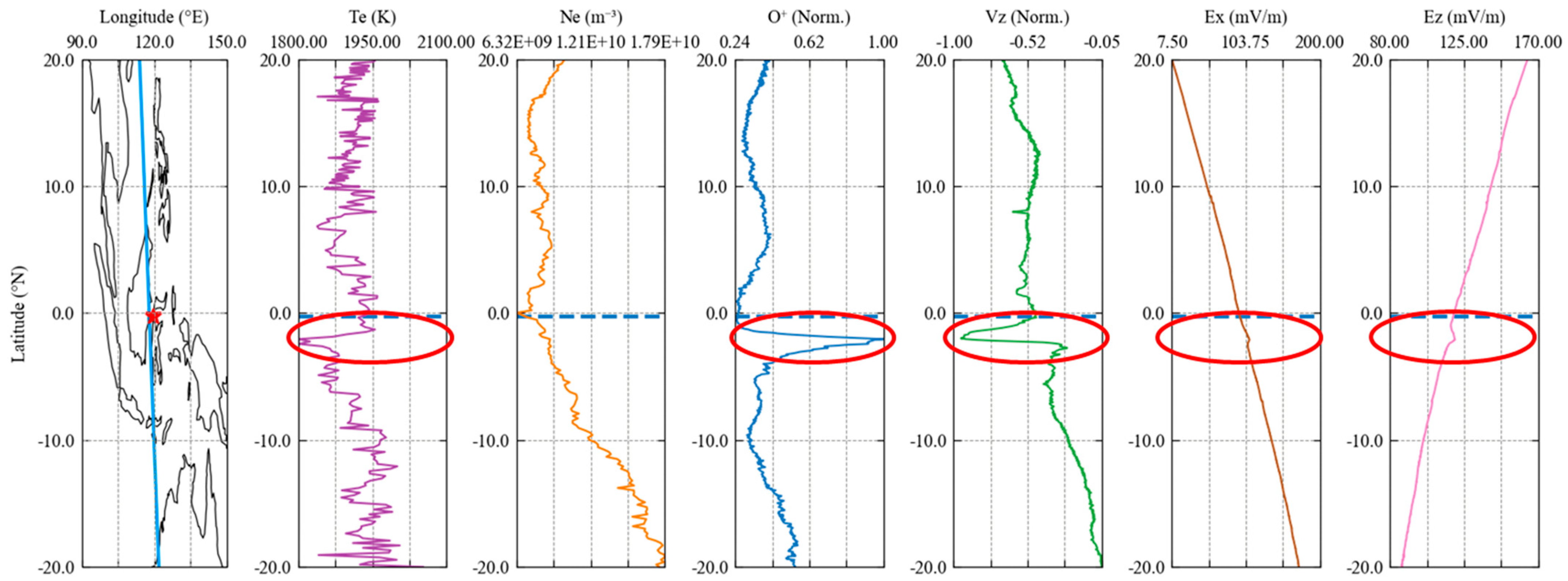
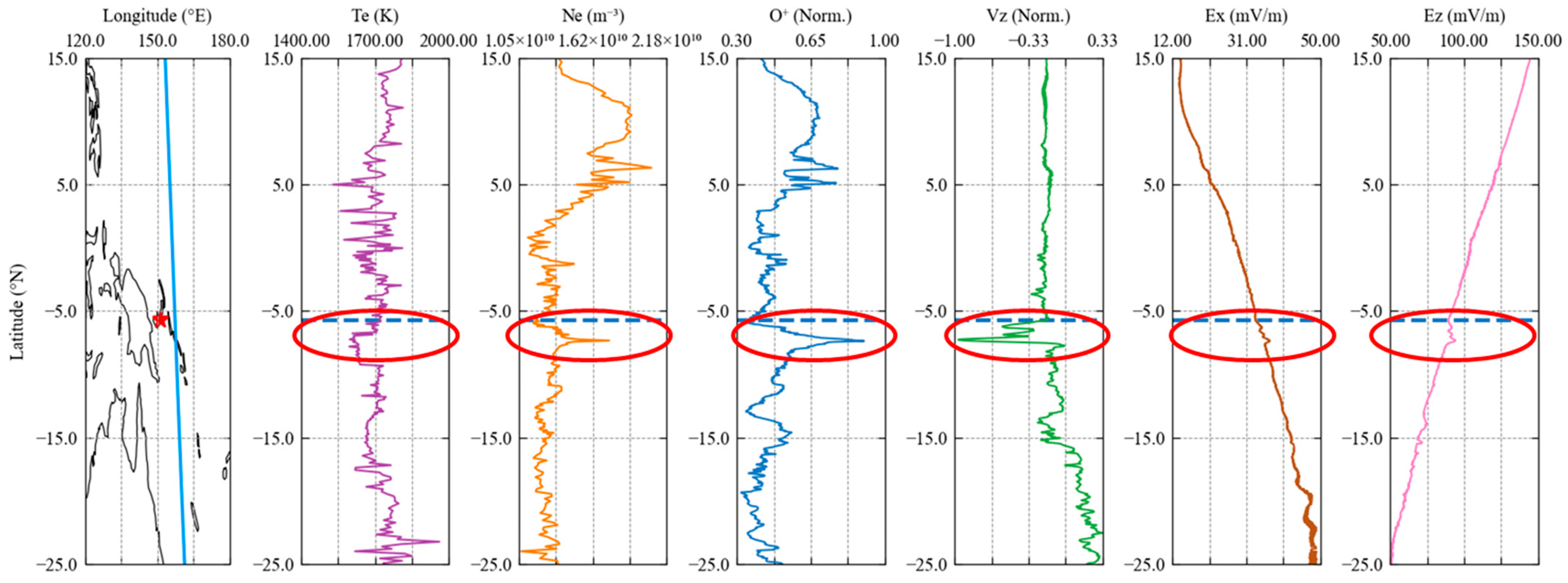

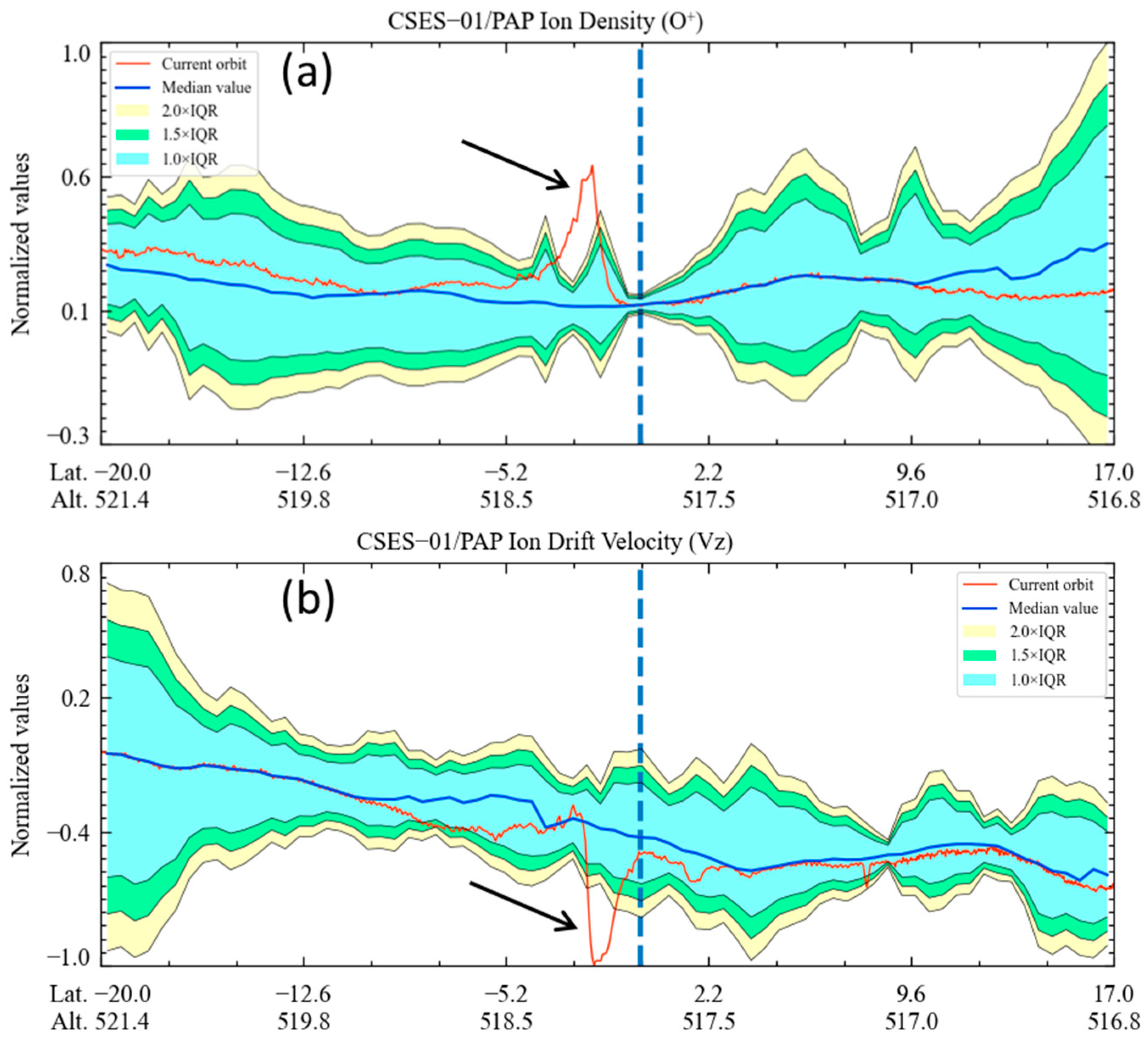
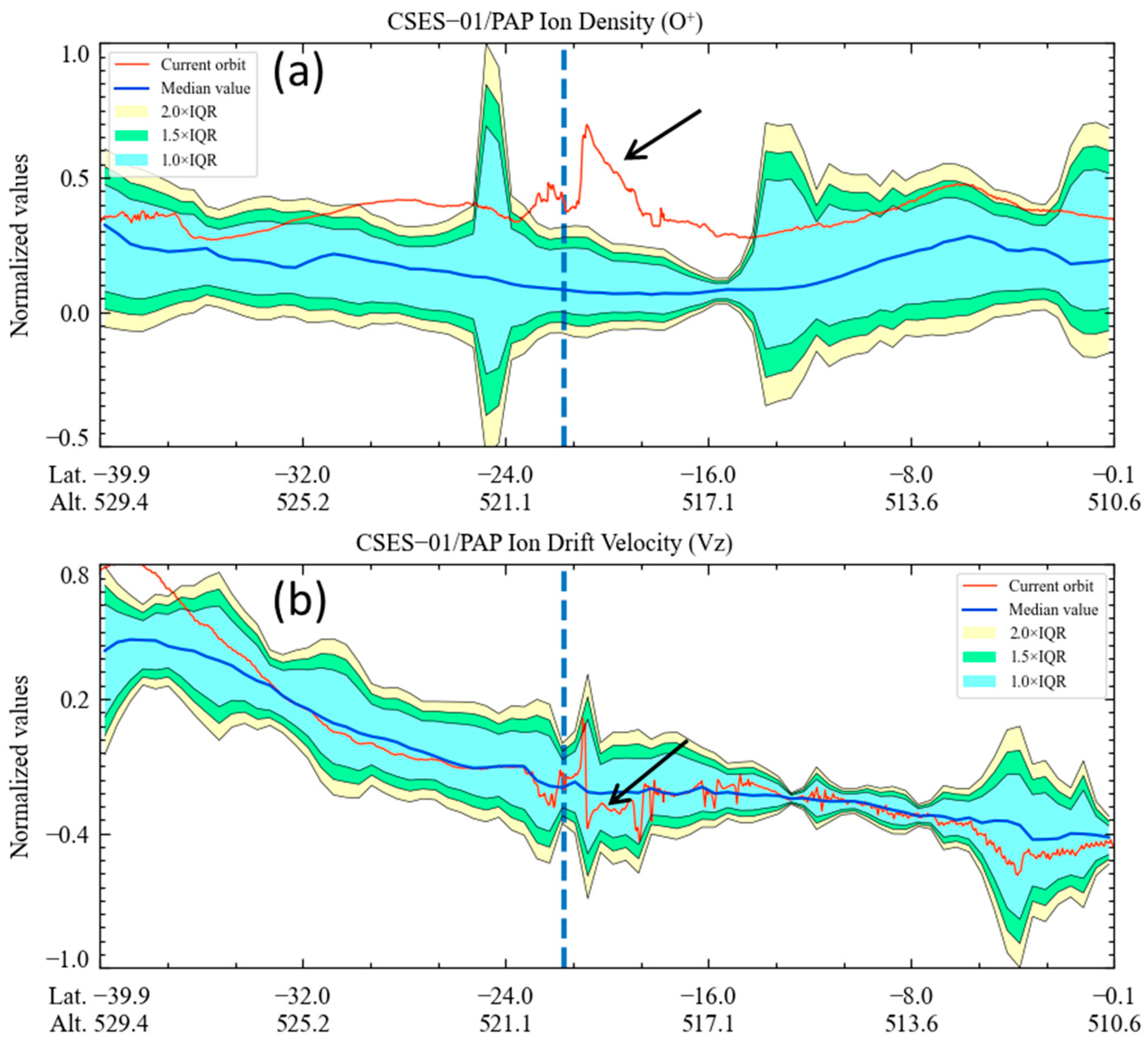
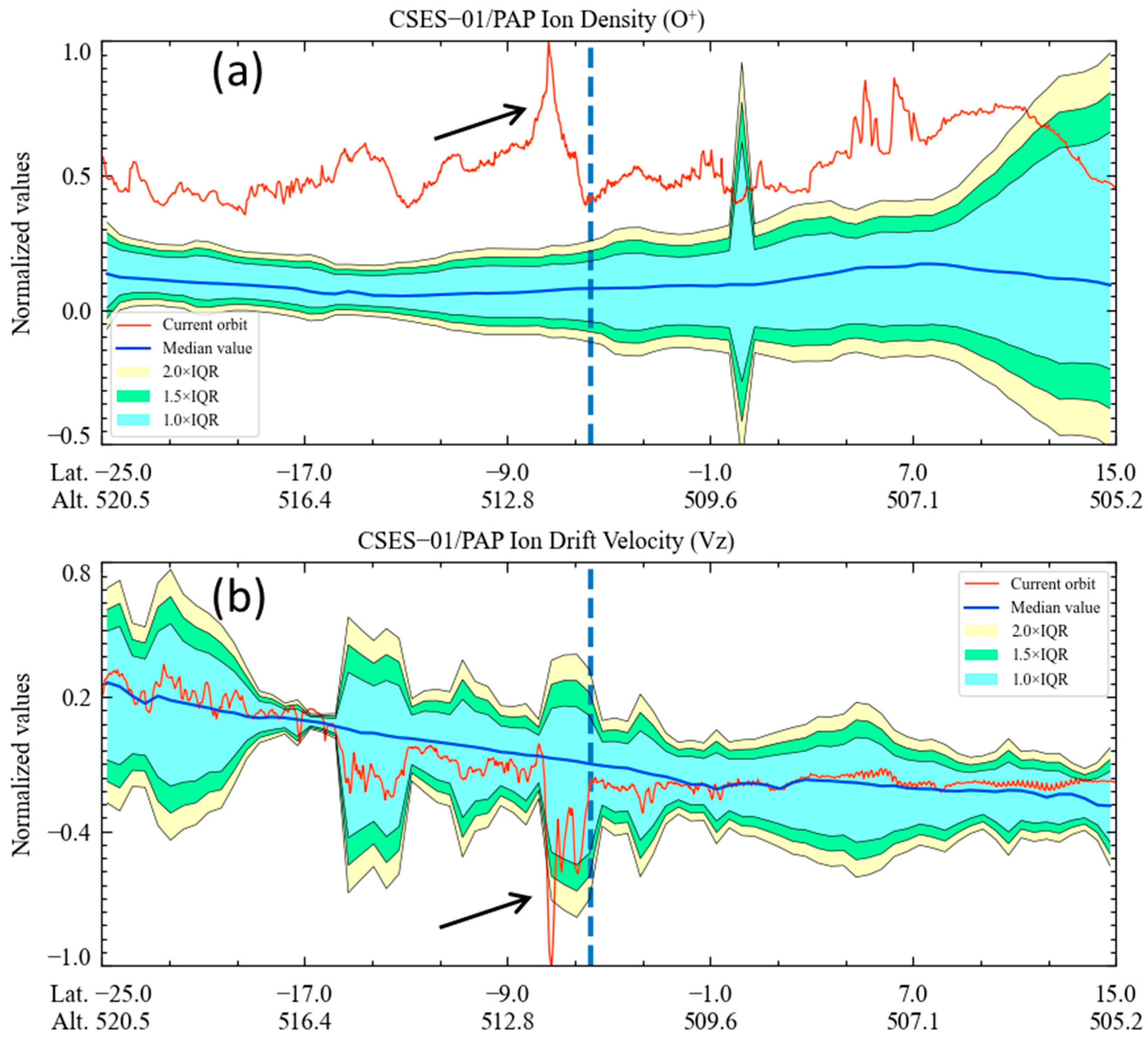
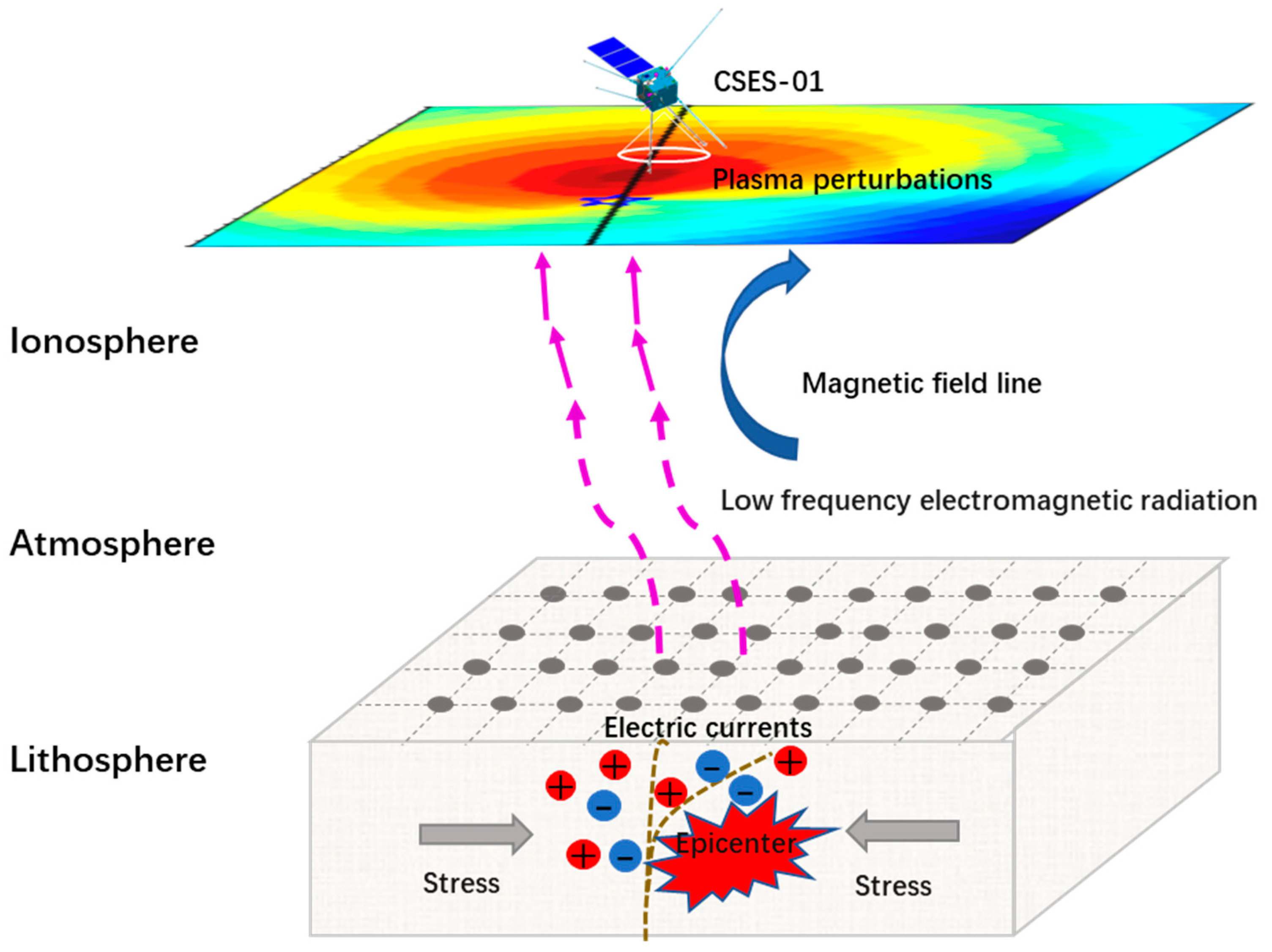
| No. | Region | Date and Time (UTC) | Magnitude (Ms/Mw) 1 | Latitude (°N) | Longitude (°E) | Focal Depth (km) |
|---|---|---|---|---|---|---|
| 1 | Loyalty Islands | 29 August 2018 at 03:51:54 | 7.1/7.1 | −21.95 | 170.10 | 20 |
| 2 | Southeast of Loyalty Islands | 16 August 2018 at 01:03:42 | 6.9/6.5 | −21.65 | 169.61 | 17 |
| 3 | Indonesia | 28 September 2018 at 10:02:44 | 7.4/7.5 | −0.25 | 119.90 | 20 |
| 4 | Papua New Guinea | 10 October 2018 at 20:48:18 | 7.1/7.0 | −5.70 | 151.25 | 39 |
Disclaimer/Publisher’s Note: The statements, opinions and data contained in all publications are solely those of the individual author(s) and contributor(s) and not of MDPI and/or the editor(s). MDPI and/or the editor(s) disclaim responsibility for any injury to people or property resulting from any ideas, methods, instructions or products referred to in the content. |
© 2023 by the authors. Licensee MDPI, Basel, Switzerland. This article is an open access article distributed under the terms and conditions of the Creative Commons Attribution (CC BY) license (https://creativecommons.org/licenses/by/4.0/).
Share and Cite
Liu, D.; Zeren, Z.; Huang, H.; Yang, D.; Yan, R.; Wang, Q.; Shen, X.; Liu, C.; Guan, Y. The Ionospheric Plasma Perturbations before a Sequence of Strong Earthquakes in Southeast Asia and Northern Oceania in 2018. Remote Sens. 2023, 15, 5735. https://doi.org/10.3390/rs15245735
Liu D, Zeren Z, Huang H, Yang D, Yan R, Wang Q, Shen X, Liu C, Guan Y. The Ionospheric Plasma Perturbations before a Sequence of Strong Earthquakes in Southeast Asia and Northern Oceania in 2018. Remote Sensing. 2023; 15(24):5735. https://doi.org/10.3390/rs15245735
Chicago/Turabian StyleLiu, Dapeng, Zhima Zeren, He Huang, Dehe Yang, Rui Yan, Qiao Wang, Xuhui Shen, Chao Liu, and Yibing Guan. 2023. "The Ionospheric Plasma Perturbations before a Sequence of Strong Earthquakes in Southeast Asia and Northern Oceania in 2018" Remote Sensing 15, no. 24: 5735. https://doi.org/10.3390/rs15245735
APA StyleLiu, D., Zeren, Z., Huang, H., Yang, D., Yan, R., Wang, Q., Shen, X., Liu, C., & Guan, Y. (2023). The Ionospheric Plasma Perturbations before a Sequence of Strong Earthquakes in Southeast Asia and Northern Oceania in 2018. Remote Sensing, 15(24), 5735. https://doi.org/10.3390/rs15245735









